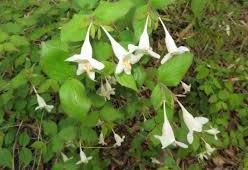Diabelia tetrasepala
(Diabelia tetrasepala)

Description
Diabelia tetrasepala is a species of flowering plant in the family Honeysuckle. This species wasfirst scientifically described by Gen'ichi Koidzumi in 1915 under the name Abelia spathulata var. tetrasepala. In 1955 Hara and Kurosawa upgraded it to species with the nomenclature Abelia tetrasepala. In 2010 Sven Landrein transferred it to the genus Diabelia. This species is a deciduous, multi-branched shrub growing to 2-3m tall. The branches are oblong, bark grey-brown, white solid spongy core, annual branches hairless and few glandular, but sometimes hairy, often becoming reddish brown. Leaves opposite, petiole 1-3 mm, often hairy. The leaf blade is 3-6 cm long, 1.5-3.5 cm wide, ovate to broad, lanceolate, apex from pointed to long, base from broad to rounded wedge-shaped. The margins of the leaves are rough and irregular, and the margins of young leaves are often reddish in color. The distal leaf blade surface is smooth or hairy on the veins, the proximal surface is hairy, especially the veins and margins, with white hairs up to 1.2 mm long. There are 3-4 pairs of lateral tendons sloping back toward the apex. The upper surface of the leaf blade is slightly compressed and the lower surface is raised. Each inflorescence usually consists of 2 flowers growing at the tips of young branches, with flower stalks 1-2 mm long and 1 bract and 2 bracts. Calyx 5 sepals, of which a small sepal is 2-5 mm long and may be rare, the other four sepals are 8-15 mm long, lanceolate to oblong, durable. Corolla two-lipped, 3-4 cm long and lower part of corolla 10-15 mm long, bell-shaped or funnel-shaped, usually yellowish-white, sometimes yellow or pinkish, with yellow reticulate markings orange face inside the lower lip. Upper lip 2 lobes, lower lip 3 lobes, lower part of colic canal narrowed. Stamens 4, two staggered pairs, with 2 stamens nearly equal to the length of the corolla tube, anthers 2.5-3 mm long. The pistil is as long as the corolla tube. The ovary is 8-11mm long. The fruit is 10-15 mm long, ripe in September-October. A narrow cylindrical seed 7-8 mm long, with short wings at both ends. The species is endemic to Japan, from western Fukushima on Honshu as well as at Shikoku. Rare in northern Kyushu. It has larger flowers than Diabelia spathulata, as well as flowers about 2 weeks earlier than this species, from mid-April to May.
Taxonomic tree:







